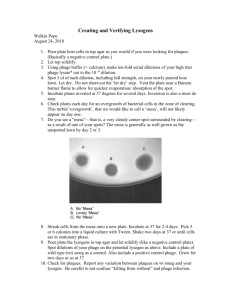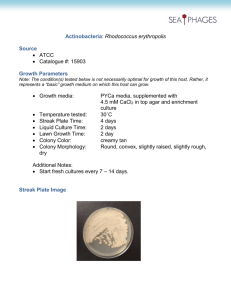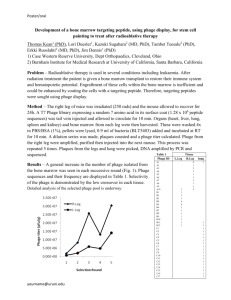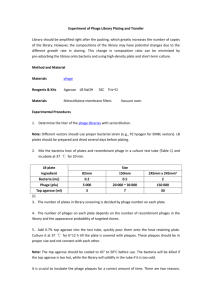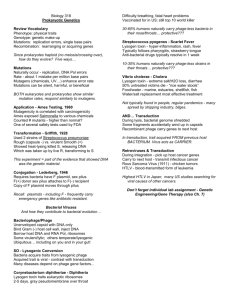Exam 2
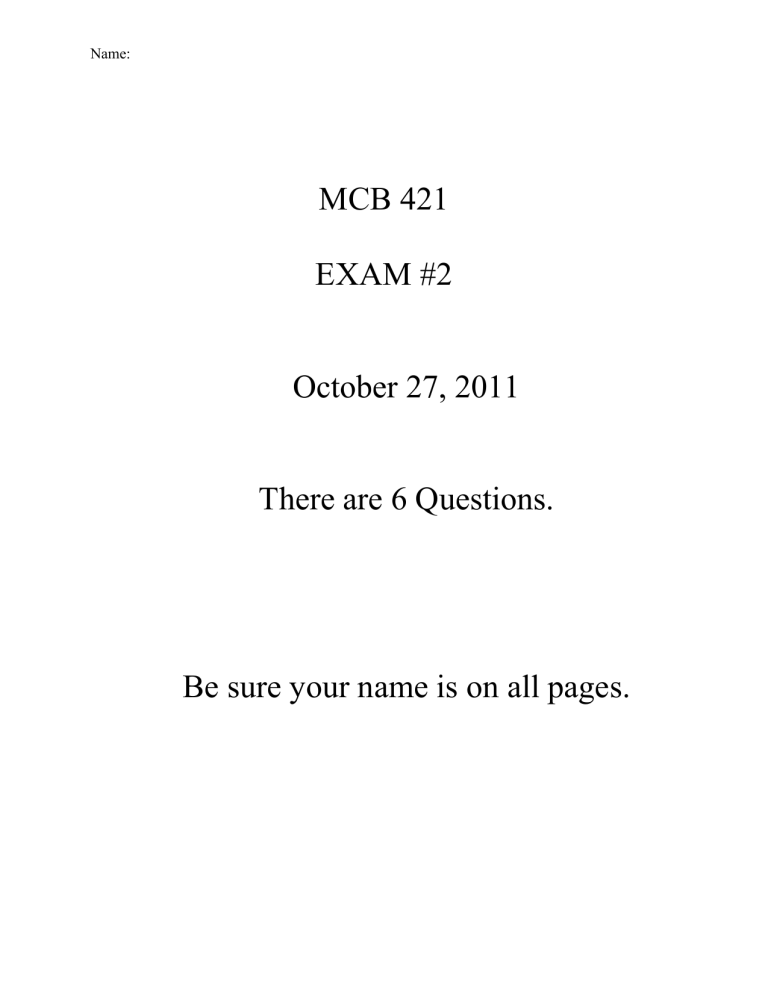
Name:
MCB 421
EXAM #2
October 27, 2011
There are 6 Questions.
Be sure your name is on all pages.
Name:
1. (12 points) What would a “one step growth curve” (of bacteriophage) look like if:
(Can do on one graph. Label Clearly) a. (3 points) You used a host that was not infected by your phage? b.
(3 points) If you phage could infect but not grow lytically? c.
(3 points) If your phage was wild type, but was grown on a K strain (rK+mK+), and then used to infect a B strain (rB+mB+) strain? d. (3 points) The WT phage infected the cells and lysed out after 45 minutes.
A: Phage titer stays the same high level because the host cannot be infected.
B: Phage titer stays at a low level because the phage infects and the titer of free phage in the culture decreases. Because the phage can’t grow lytically, no progeny phages are released.
C: A slight increase in the titer due to the few number of phage that escape restriction, get modified and then are able to grow lytically.
Name:
2. (12 Points). A temperature sensitive mutation was isolated in the gene encoding NAD kinase from Salmonella [Cheng and Roth. 1994. J. Bacteriol. 176: 4260-4268]. Two factor crosses were done to map the nadF mutation against nearby markers. The lip gene encodes enzymes required for the biosynthesis of lipoate and the cam gene encodes resistance to chloramphenicol. Given the results shown below, draw a genetic linkage map showing the most likely gene order and the coinheritance frequencies with arrows pointing toward the selected marker. [You do not need to refer to the reference to answer the following questions.]
Donor Recipient Recombinants # obtained lip- nadF+ lip+ nadF-
Selected phenotype
NadF+ cam+ nadF- lip- cam+ cam- nadF+ lip+ cam-
Cam+
Cam+
Lip-
Lip+
NadF-
NadF+
Lip-
Lip+
25
475
20
180
4
496
Answer:
Name:
3. (12 points) A deletion map of the maltose transport operon from Salmonella typhimurium is shown below [from Schneider, E., L. Bishop, E. Schneider, V. Alfandary, and G. F. Ames. 1989.
J. Bacteriol. 171: 5860-5865]. The region removed by each deletion is shown by the box below the genes and the corresponding allele number is indicated above each line.
The map position of several mal mutations was determined by mapping against these deletions.
The results are shown in the following table. Given these results, indicate the map position for each of the mutations on the deletion map. Indicate precisely which deletion interval the mutations map in. If it is not possible to determine whether a mutation maps in a single interval, be sure to comment on this in your answer and suggest a reason that might cause such a result.
[Hint: use a ruler to draw the endpoints of the deletion intervals on the map, then you can identify each deletion interval with a number or letter.] (Table of Last Page of Exam)
Name: mal+
+
+
+
+
+
+
+
+
+
+
+
+
+
+
+
+
+
+
+
+
+
+
Recipient
∆mal-213
∆mal-243
∆mal-244
∆mal-245
∆mal-246
∆mal-247
∆mal-248
∆mal-250
∆mal-676
∆mal-677
∆mal-681
∆mal-683
∆mal-684
∆mal-685
∆mal-687
∆mal-690
∆mal-691
∆mal-692
∆mal-694
∆mal-695
∆mal-696
∆mal-698
Mal+ recombinants with donor DNA from:
+
+
+
+
+
+
+
+
+
+
+
+
+
+
+
−
+
+
−
−
−
+ mal-220 mal-229 mal-218 mal-232 mal-235 mal-689
+
+
+
+
−
−
−
−
−
−
−
−
−
−
+
+
+
+
+
+
−
+
−
+
+
+
+
−
+
+
+
+
−
−
−
−
+
+
+
+
−
+
+
+
+
+
+
+
−
+
+
+
+
−
+
+
+
+
+
+
−
−
−
−
+
−
+
+
+
+
−
+
+
+
+
−
+
+
+
+
+
+
−
−
−
−
+
−
+
+
+
+
−
+
+
+
+
−
+
+
+
+
−
−
−
−
−
−
+
−
Name:
4.
(14 points)
Complementation analysis was done on six mutants that lack gatonine synthetase activity. The order of the mutational sites is not known. The results are shown below: gat-1 gat-2 gat-3 gat-4 gat-5 gat-6 gat-1 - + + - - - gat-2 gat-3 gat-4
- -
-
+
+
-
+
+
-
-
-
- gat-5 gat-6
- -
- a.
(3 points)
How many complementation groups are represented?
Answer: At least two complementation groups:
Group 1 = gat-1, gat-4, gat-5
Group 2 = gat-2, gat-3
Ungrouped = gat-6 b.
(4 points)
Suggest an explanation for the results for gat-6.
Answer: gat-6 fails to complement all of the other mutants. This could be either due to a trans-dominant negative phenotype of this mutant (e.g. due to a missense mutation that poisons gatonine synthetase) or a cis-dominant negative phenotype caused by the mutation
(e.g. due to an amber mutation that prevents expression of downstream genes). c. (7 points) Suggest a simple experiment that would make the interpretation of the gat-6 results more definitive.
Answer: Check gat-6 with wild –type to see if WT is cis dominant or recessive.
Name:
5. (35 points). The diagram below shows the immunity region of phage λ. The genes are:
cI – codes for cI repressor. The cI857 allele is temperature sensitive.
cro – codes for Cro protein.
N – codes for the transcription anti-terminator.
cII – codes for cI activator.
cIII – codes for the cIII protease inhibitor.
OL 1,2, and 3 and OR 1,2, and 3 are operators.
PL and PR are the rightward and leftward promoters.
PRE is the promoter for repressor establishment.
PRM is the promoter for repressor maintenance.
Calef et al. isolated a mutated lysogen that deleted most lambda DNA on the right and left sides of the immunity region as shown below. The mutant also has the cI857 TS allele (regions not shown below are deleted):
The lysogen had always been maintained at 30° C previously to the experiment described below.
They grew the lysogen at 30° C until cells reached mid-log growth. They split the culture in half and grew one at 30° C (Culture A) and the other at 42° C (Culture B) for several hours. They then used the cells from each culture as indicator bacteria for the ability of wt λ and λ imm434 to form plaques to 30° C. They obtained the results shown in the Table:
Indicator Cells Cells Infected with wt λ Infected with λ imm434
Grown at 30° C (A) no plaques normal, turbid plaques
Grown at 42° C (B) clear plaques turbid plaques
The indicator cells grown at 42° C were returned to 30°C (Culture C) and grown for several generations and checked again for plaquing by wt λ and λ imm434 at 30°C. They obtained the same results as with Culture B as with the cells grown at 42° and not shifted back to 30° (i.e. they still obtained clear plaques with wt λ and turbid plaques with λ imm434).
Name: a. (5 points) Why doesn't wt λ form plaques on the indicator lysogen grown at 30° C (Culture
A)?
ANSWER: At 30°C, the cI857 repressor in the lysogen is active and will bind to the right and left operators of the infecting phage. This will prevent transcription of any phage proteins and thus prevent lysis. b. (5 points) Why can λ imm434 (as opposed to wt λ, above) form plaques on the indicator lysogen grown at 30° (Culture A)? Why are the plaques turbid?
ANSWER: λ imm434 has the immunity region from phage 434, so the λ repressor is unable to bind its operators and repress transcription. So, the infecting phage may lyse the indicator. The plaques are turbid because the λ imm434 will eventually start making its own cI-like repressor (probably once the MOI becomes high) and form lysogens. c. (5 points) Why does wt λ form clear plaques on the indicator strain if it is grown at 42°C
(Culture B)?
ANSWER: λ is able to form plaques on the lysogen at 42° because the cI857 repressor is inactive at 42° and so does not prevent lytic growth by the infecting phage. The lack of cI in the recipient lysogen leads to accumulation of cro protein. Cro protein prevents transcription of cI, both in the lysogen and in the incoming phage. This ensures that incoming phage will only be able to grow lytically, and so the plaques are clear. d. (5 points) Why doesn't growth of the indicator lysogen at 30°C (Culture C) for several hours restore the original phenotype (no plaques with wt λ) of indicator cells once they have been grown at 42°?
Answer: Once cI is deactivated at 42°, transcription of cro protein starts. Once cro protein is present, it prevents transcription of cI, even when the temperature is shifted back down to 30°C. Thus, the lysogen loses immunity even when shifted back to 30°.
Name: e. (10 points) In another experiment the cells grown at 42 o
C for several generations and then grown at 30 o
C for several generations (Culture C) were transformed with a plasmid that contains the wild-type cII gene cloned downstream of the P
Lac
promoter. (Thus expression of cII can be turned on by adding IPTG or turned off by deleting IPTG from the medium).
The cells were the grown at 30 o
C and split in half. One half were induced with IPTG and the other half were grown in the absence of IPTG. When the cells were used as indicator strains for infection with wild-type lambda at 30 o
C, the following results were obtained:
Cells Grown Cells Infected with Wild-Type Lambda
- IPTG clear plaques
+ IPTG no plaques
What is the explanation for these results? Be specific about the mechanism. Why are the plaques clear?
Answer: In the absence of IPTG we see clear plaques for the same reason as in (d). The
Cro protein prevents transcription of cI from the infecting phage and the prophage. Thus the plaques are clear because the phage can only grow lytically.
In the presence of IPTG, the cII gene is turned on. cII is activating transcription of cI from P
RE
so that the concentration of cI+ and cI857 increases. The accumulation of cI represses transcription from P
R
so cro and the lytic genes are not expressed. Thus, we don’t see plaques. [Since Int is also made from P
I
, the phage should also integrate into the chromosome]). f. (5 points) The cells that were grown in the presence of IPTG (above) were cured of the plasmid carrying P
Lac
cII (don’t worry about how this was done), What would happen if these cells were infected by wild-type lambda at 30 o C?
Answer: The growth with IPTG and expression of cII should have “flipped” the switch back so that cI857 is expressed at 30 o C. This infection of lambda at 30 o C would result in no plaques .
Name:
6. (15 points) You have three strains of S. typhimurium .
Strain #1- recA - srl ::Tn 10 trp +. The srl + gene allows cells to use sorbitol as a sole C-source.
The srl ::Tn 10 insertion prevents cells from using sorbitol as a sole carbon source and makes them resistant to tetracycline (tetR).
Strain #2- recA - srl + trp +.
Strain #3- recA + srl + trp ::MudJ.
Other relevant information:
-The recA and srl genes are 80 % cotransduced by phage P22. The trp operon is unlinked to recA or srl by P22 transduction.
-The trp ::MudJ makes the cell a tryptophan auxotroph and makes it resistant to kanamycin
(KanR).
recA - cells can be distinguished from recA + by checking for UV sensitivity.
You need to make a strain that contains recA - srl + and trp ::MudJ. Using P22HT and the three strains above devise a scheme that would allow you to make the desired strain . Be sure to clearly diagram the genetic events involved in each step. Also specify the media used in each step.
Answer: (Since transduction recipients need to be recA + for homologous recombination to occur, the last step should be the introduction of recA - srb + into the trp ::MudJ recipient.
This could be done using a recA + srl - trp ::MudJ recipient and selecting for srl + and screening for UV sensitivity. The preexisting RecA+ protein in the recipient will allow homologous recombination to occur incorporating the recA - allele. After several generations the preexisting RecA+ protein will be diluted out).
Step 1- Make a P22 HT lysate of strain #1 and transduce the srl ::Tn 10 into strain #3 by selecting for tetR (LB + tet plates (kan not required but OK)) and screening for uvS and uvR. Save a uvR ( recA +) recombinant identified by screening for uvS and uvR. (Must show events that select for tetR and both uvS and uvR). This will yield a strain that contains the recA + srl ::Tn 10 trp ::MudJ, (This can be used as a recipient for transductions because it makes RecA+ protein).
Step 2- Make a P22HT lysate of strain #2 and transduce the strain above by selecting for srl + on minimal sorbital plates supplemented with tryptophan. (important- no tet). This will select for srl +. Screen for uvS and uvR, The uvS will be the desired strain. (Must show events that lead to uvS and uvR).
Name:
